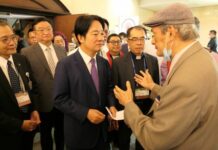September 19-25, 2011
Headline News
Seediq Bale rekindles interest in history and stirs new discussion on faith and identity
Reported by Chiou Kuo-rong, Sam Lee
Written by Lydia Ma
The hype surrounding the new film “Seediq Bale” started well before the release of the film on September 9, 2011, and it provided a great opportunity to review history and renew society’s interest on the rights of indigenous peoples. The movie raises numerous issues through many of its complex cast of characters.
Taking advantage of the present momentum, PCT Indigenous Committee held a symposium on September 19 on the theme of spiritual awakening and self-identification of indigenous groups. The symposium also studied the present challenges facing indigenous groups as well as their future goals. Rev. Oseng from East Amis Presbytery said during his speech that he was very pleased with the movie and liked how it showed indigenous groups defying unreasonable government authorities to preserve their human dignity.
The symposium consisted of 3 main sections, namely, “Seediq Bale: From a historical and humanistic point of view”, “Spiritual awakening and self-identification of indigenous groups”, and “Seediq Bale: How the Japanese resistance then applies to Indigenous groups’ modern struggles and future visions.”
At the end of this forum, PCT Indigenous Committee Secretary Omi Wilang said he hoped this would mark the beginning of a new phase where indigenous groups work with one another and collaborate with one another, instead of being fragmented and each doing their own thing. The meeting was then adjourned with a closing prayer.
In related news, PCT Sediq (also spelled Seediq or Seejig) district members were invited to visit Wushe Street in Linkou on September 13 where the filming of Seediq Bale took place. Sediq district director Peto Ukan said that a tour of this street, now renown because of the movie, helped many of his people born after the Wushe Incident to revisit their tribe’s history and identity. For those who experienced this tragedy, the visit brought back many memories.
About 200 Sediqs were invited to visit Wushe Street by New Taipei municipal government just before the area, which was restricted because of filming, became open to the public. Seediq Bale director Wei Te-sheng is said to have done an extensive research about the street and spent close to NT$80 million to make the street resemble what it looked like in the 1930s.
Rev. Watan Diro, who was appointed cultural consultant of the movie, said that both adults and children who saw this film were inspired. For the older generation, whose parents or relatives were affected by the Wushe Incident, the movie brought tears. For the younger generation, it was an opportunity to get to know their tribe’s history better.
Watan Diro said the 3 sub-groups that make up the Sediq tribe used to be bitter rivals who harbored resentment against one another. Today, the gospel has changed their relationship and banished all hate. But the movie is nevertheless a sobering reminder of how rulers ruthlessly assimilate indigenous groups. In his opinion, the KMT and the Japanese are not much different in this aspect.
Sediq people are a minority group in modern day Wushe, Watan Diro said. But he is thankful that God has given these people new hope through the gospel and that they are now God’s children.






